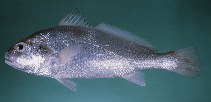| Family: |
Sciaenidae (Drums or croakers) |
| Max. size: |
34.8 cm TL (male/unsexed) |
| Environment: |
benthopelagic; freshwater; brackish; marine; depth range 0 - 132 m |
| Distribution: |
Indo-West Pacific: Persian Gulf eastward to southern China and Taiwan and northern and northeastern Australia and New Guinea. |
| Diagnosis: |
Dorsal spines (total): 10-12; Dorsal soft rays (total): 27-32; Anal spines: 2-2; Anal soft rays: 7-8. Snout rounded but not swollen or projecting; mouth large, oblique; upper jaw extending backward below posterior half of eye; no barbel on chin; teeth in narrow bands, well differentiated into large and small in both jaws, but none canine-like; gill rakers slender, about half length of gill filaments at angle of arch, 9 to 15 on lower limb. Second anal spine moderately long, 24 to 42 % of head length. Scales on head cycloid (smooth). Swim bladder hammer-shaped, the first pair of arborescent appendages entering head beyond transverse septum and sending a palmate branch to the front of pectoral arch. Sagitta (large earstone) with a tadpole-shaped impression, the head of which has its long axis lying obliquely to that of sagitta and the tail expanded and deepened as a hallow cone connected with the head by narrow groove. |
| Biology: |
Inhabits shallow coastal waters, estuaries, and rivers. In India, matures at the size of 14 to 16 cm TL; attains an average size of 15.8 cm TL, 20.6 cm TL, and 24 cm TL, at the end of 1 year, 1.5 years and 2 years, respectively. Juveniles prefer crustaceans and as they grow , show piscivorous tendency (Ref. 9772). Marketed fresh and dried salted (Ref. 3490). |
| IUCN Red List Status: |
Least Concern (LC); Date assessed: 27 September 2018 Ref. (130435)
|
| Threat to humans: |
harmless |
Source and more info: www.fishbase.org. For personal, classroom, and other internal use only. Not for publication.
